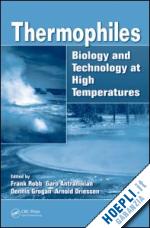We might think of them as living on the very edge of existence. Referred to as extremophiles, these microorganisms exhibit the most radical capacity for adaptation in those harsh environments that are just barely conducive to the existence of cellular life. Unlocking the mechanisms and understanding the evolutionary development that allows these simple organisms to thrive can teach us much about microbiology in extremis. Highly diverse, these microorganisms are found nearly everywhere. One example, thermophiles are microorganisms that thrive at temperatures above the mesophilic range of 25-40 degrees C. Until recently, due to their extreme environment, the study of thermophiles was limited. However with the advent of new tools, particularly genetic analysis, remarkable strides have been made. Thermophiles: Biology and Technology at High Temperatures presents a cogent summary of the progress made in studying these extremophiles. Discover how thermophiles demonstrate extremes that indicate a lack of evolutionary constraints Much is being learned from the study of thermophiles, especially our understanding of biology at the molecular level and the genetic mechanisms that permit adaptation. Included in this volume is a discussion of protective strategies of thermophiles, including their thermostability, which allow them to maintain functional proteins. It also investigates whether hyperthermophiles employ protein phosphorylation-dephosphryation as a molecular regulatory mechanism, and provides significant clues regarding the synthesis of protein. By studying this extreme example, its subtle, yet exaggerated response mechanisms, and its development over the course of many short-lived generations, we may begin to understand the mechanisms in diseases linked to improper protein folding, and also begin to more fully understand the ingenious design of DNA, and all that such an understanding implies regarding the survival of human life in a rapidly changing environment.











